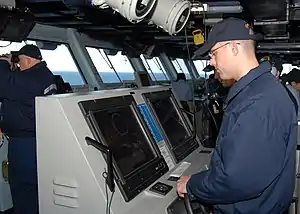Lee helm
Lee helm is the tendency of a sailboat to turn away from the wind while under sail. It is the opposite of weather helm which is the tendency of a sailboat to "round up" into the wind. A boat with lee helm will be difficult to sail Close Hauled and tacking may be difficult.
Description
Lee helm is considered dangerous in a sailboat. While sailing, if left to its own devices a boat with lee helm will bear (turn) away from the wind, accelerate, and perform an accidental or uncontrolled gybe, perhaps repeatedly. In an uncontrolled gybe the force of the wind moves the sails and boom from one side of the boat to the other. In a strong wind this movement will be very fast and forceful and can damage the boat, the sails, injure the crew, and even cause the boat to broach (lie over on its side).
The root cause of lee helm is when the center of pressure exerted by the wind on the sails falls too far forward of the center of resistance of the hull—the natural point at which the hull tries to pivot. This tends to push the bow of the boat away from the wind. This can be due to a poor design, for example with the mast too far forward.
A small amount of lee helm can be counteracted with the rudder, but this introduces significant drag in the water and slows the boat. A small amount of lee helm can also be cured by raking the mast backward, reducing the size of the Jib on a Sloop rigged boat, or increasing the size of the mizzen sail on a Yawl or a Ketch. Large amounts of lee helm can only be corrected by altering the placement of the mast(s) or keel/centerboard --- a non-trivial venture.
Lee helm on U.S. Naval Vessels

Traditionally there are two stations on the bridge of a sea going ship for controlling the vessel's maneuvers: the Helm, which uses a wheel (or touchscreen equivalent) to send signals to control the position of the rudder or rudders, and the Lee Helm, which traditionally inputs speed commands by operating an engine order telegraph that sends engine commands to the engineering personnel below decks. On modern US Navy surface vessels that use gas turbine or diesel propulsion, the lee helm actually directly controls the ship's speed via throttle control (either a manual throttle lever or a touch screen on some ships). The bridge throttle control directly manipulates propeller pitch and/or engine RPMs when the bridge station is in control, or switches to a traditional order telegraph when the bridge station relinquishes control or if the control system fails. The lee helm on vessels with nuclear propulsion (carriers and submarines) and conventional steam propulsion (amphibious assault ships prior to LHD-8) still uses a telegraph system. One possible origin for the Lee Helm designation for the Engine Order Telegraph is that large sailing ships had a helmsman at the wheel, plus an auxiliary helmsman, positioned on the leeward side of the helm – hence the term "Lee Helm" – to assist the helmsman in controlling the wheel while coming about or when the vessel is laboring in high winds or an extreme sea state.[1]
.png.webp)
The US Navy's Integrated Bridge and Navigation System (IBNS) uses two touchscreens and steering wheel for steering. The Helm is on the left, and the Lee Helm is on the right. In August 2017 the destroyer USS John S. McCain was involved in a fatal accident that killed 10 sailors. The NTSB accident report found an unreliable IBNS and lack of crew training were the causes of the accident.[2]
See also
References
- http://navyadministration.tpub.com/12966/css/12966_317.htm
-
 This article incorporates public domain material from the National Transportation Safety Board document: United States National Transportation Safety Board. "Collision between US Navy Destroyer John S McCain and Tanker Alnic MC" (PDF). (NTSB/MAR-19/01PB2019-100970) Retrieved on December 21, 2019.
This article incorporates public domain material from the National Transportation Safety Board document: United States National Transportation Safety Board. "Collision between US Navy Destroyer John S McCain and Tanker Alnic MC" (PDF). (NTSB/MAR-19/01PB2019-100970) Retrieved on December 21, 2019.